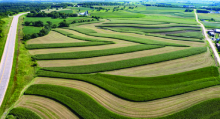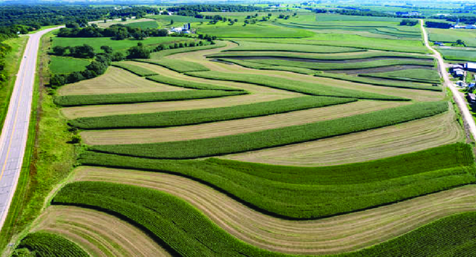- Contour strip cropping
- Contour cropping
Strip cropping is a farming method used when a slope is too steep or too long, or otherwise, when one does not have an alternative method of preventing soil erosion. It alternates strips of closely sown crops such as hay, wheat, or other small grains with strips of row crops, such as corn, soybeans, cotton, or sugar beets. This technique helps to stop soil erosion by creating natural dams for water, helping to preserve the strength of the soil. Certain layers of plants will absorb minerals and water from the soil more effectively than others. When water reaches the weaker soil that lacks the minerals needed to make it stronger, it normally washes it away. When strips of soil are strong enough to slow down water from moving through them, the weaker soil can't wash away like it normally would. As a result, farmland remains fertile for longer periods.
In addition to these benefits, strip cropping provides different forms and levels of soil cover by incorporating crops with various growth patterns, canopies, and root systems (e.g., row crops vs. forages). The alternating strips act as barriers to runoff and protect the soil during the growing season. Including strips with increased soil cover, such as grasses and legumes, reduces erosion by detachment, decreases soil particle transport, and intercepts eroded soil particles from more intensely cultivated strips.
The practice has been widespread in North America, where it was used to mitigate soil erosion and reduce dependence on mineral, and has been widely practiced in China for several decades. However, strip cropping was never widely adopted in Europe and, due to this, is generally less studied than other intercropping techniques. Possible reasons for this are an earlier mechanization of agriculture and land consolidation in Europe compared to Asia, and cultural differences.
"Contour cropping" represents tillage and planting conducted on the contour without necessarily alternating different crops in strips. Can be a single crop across the field.

